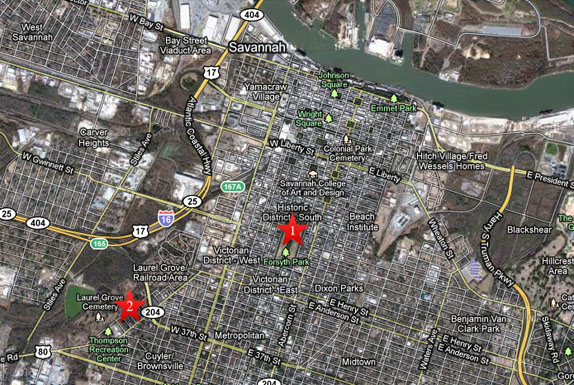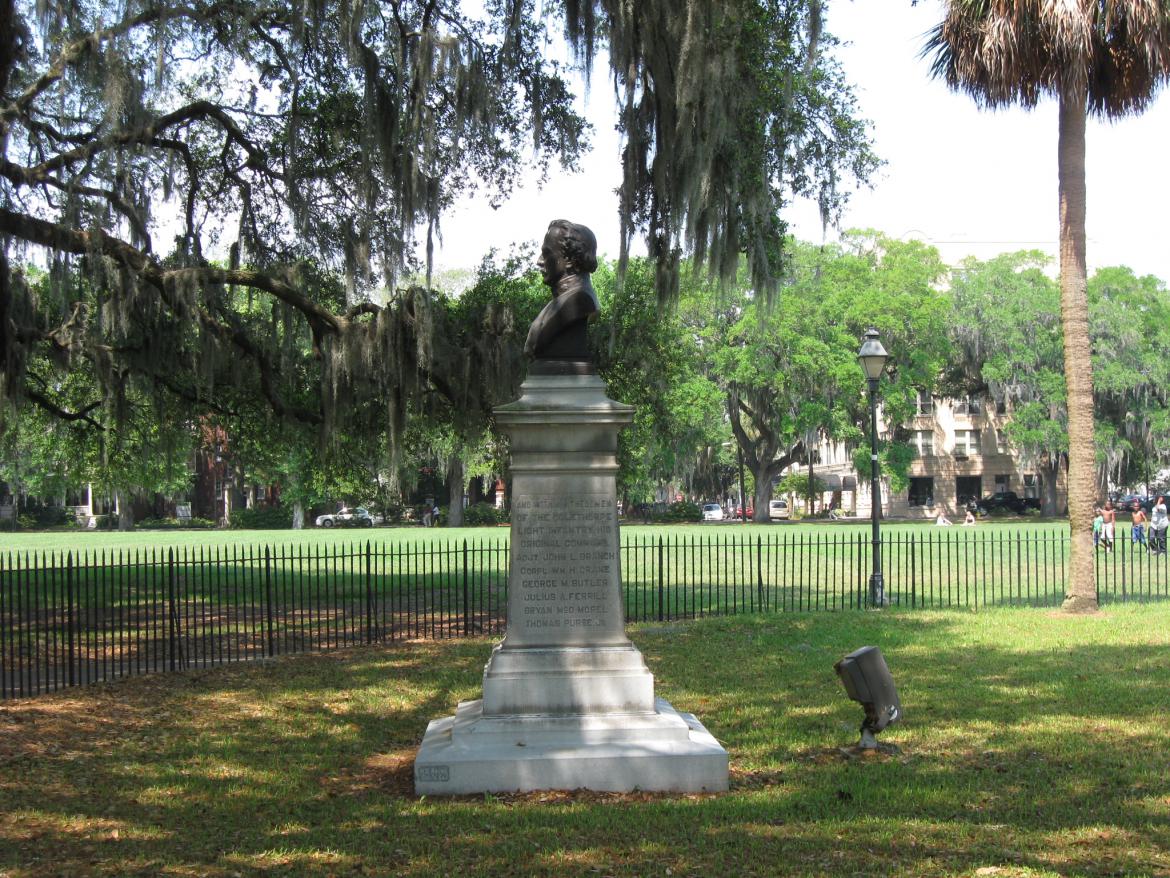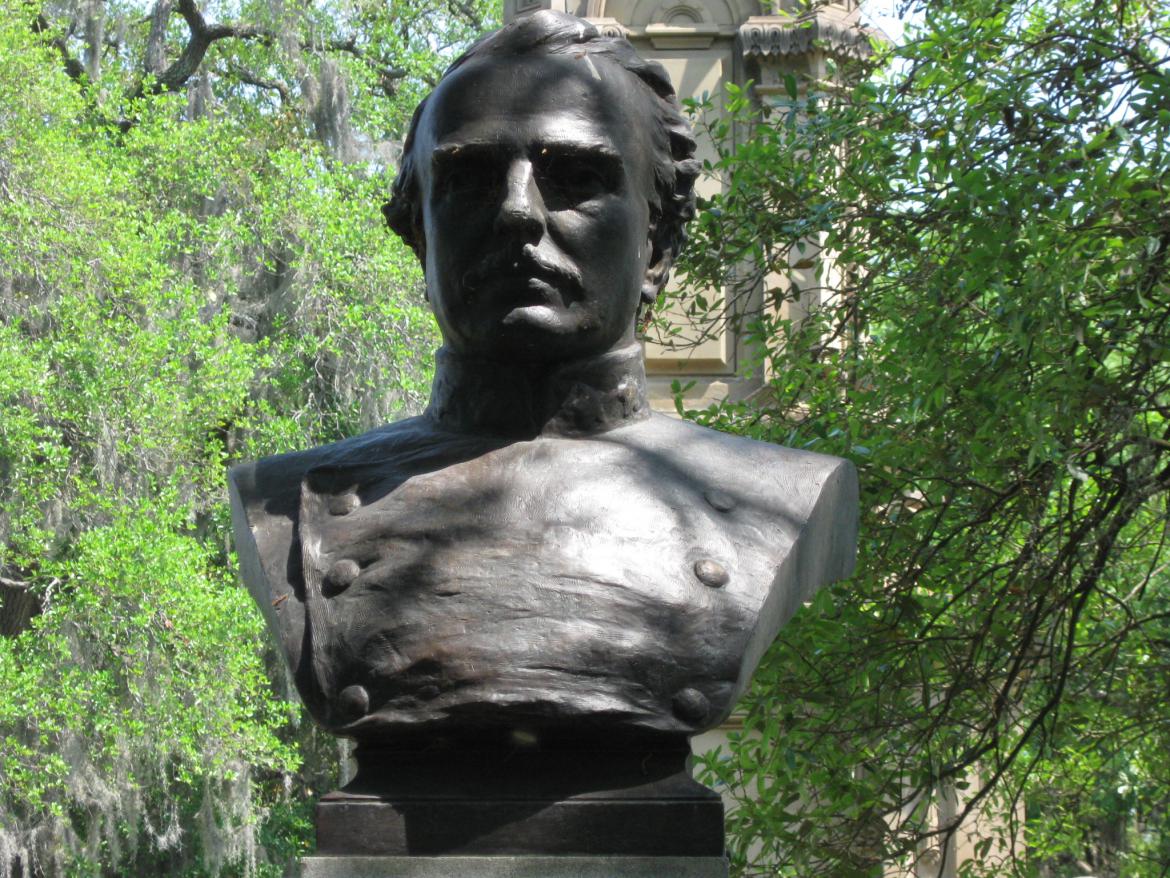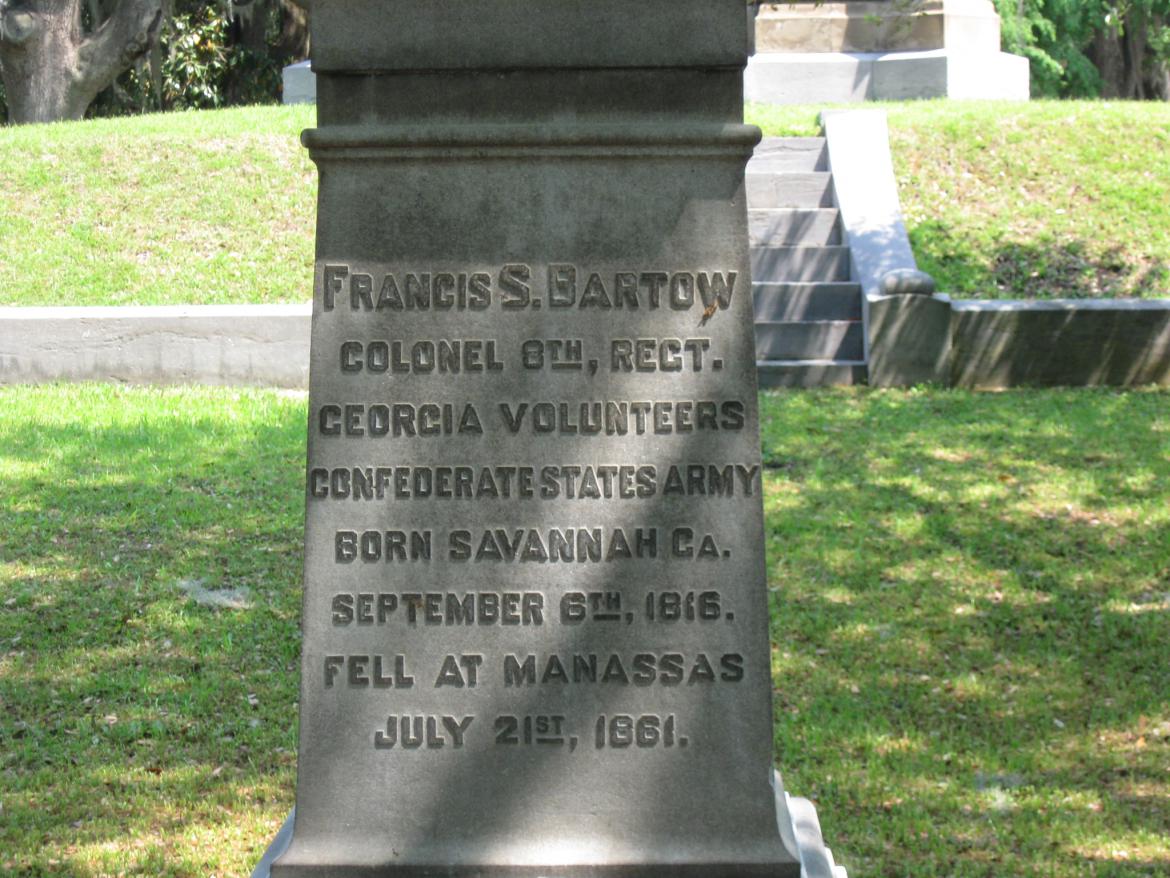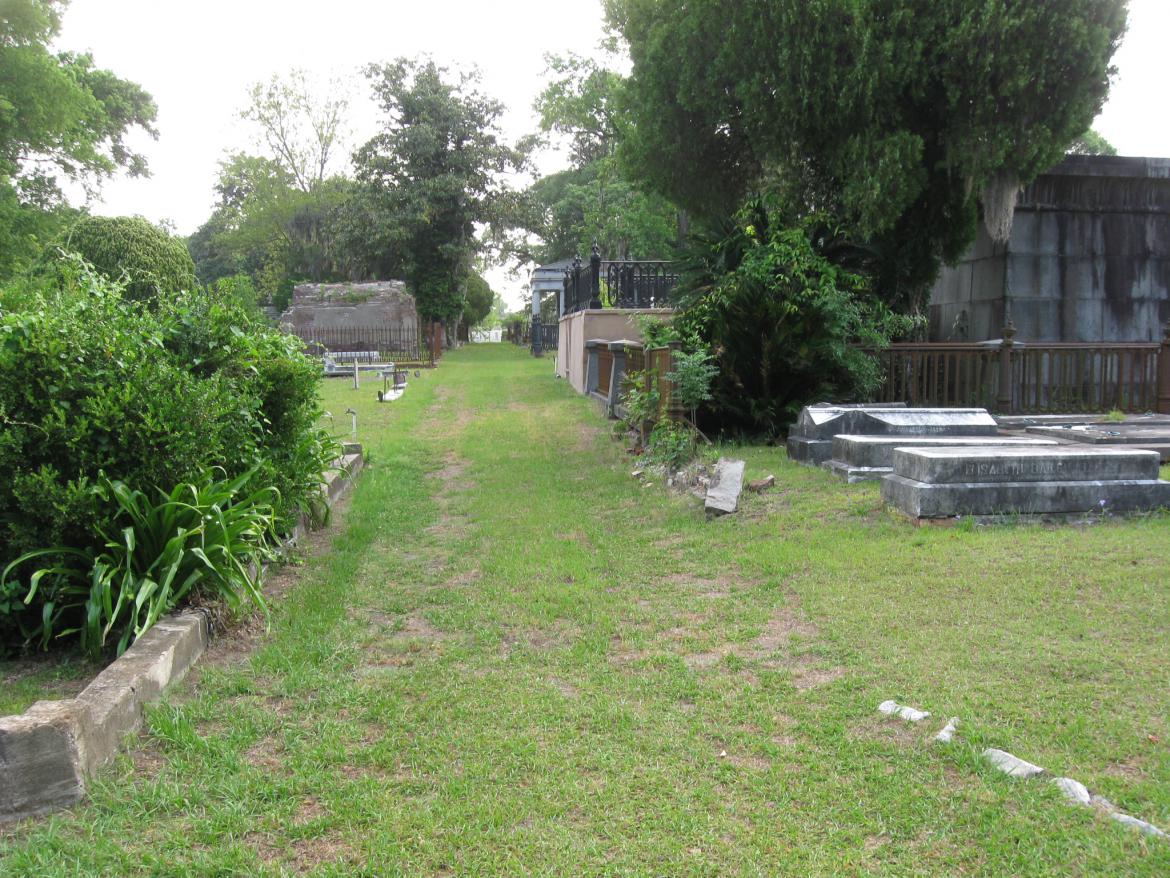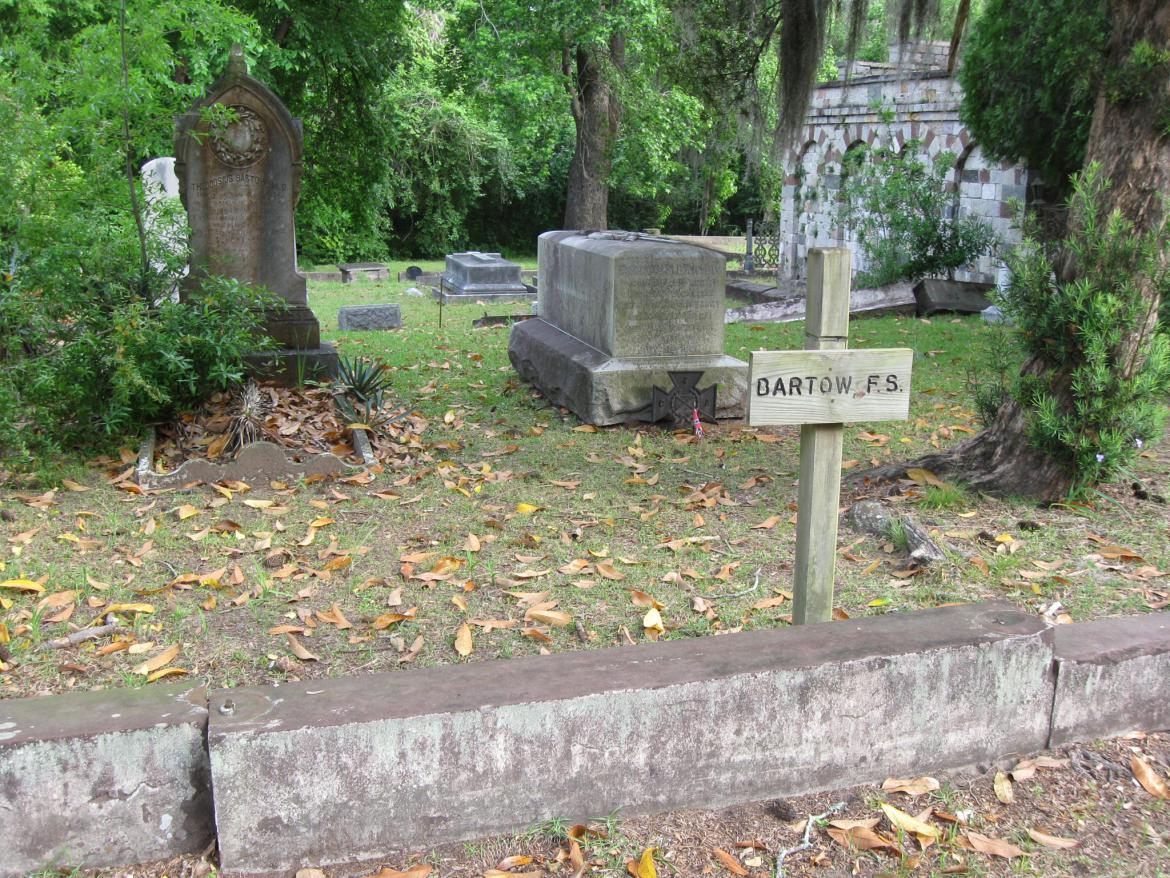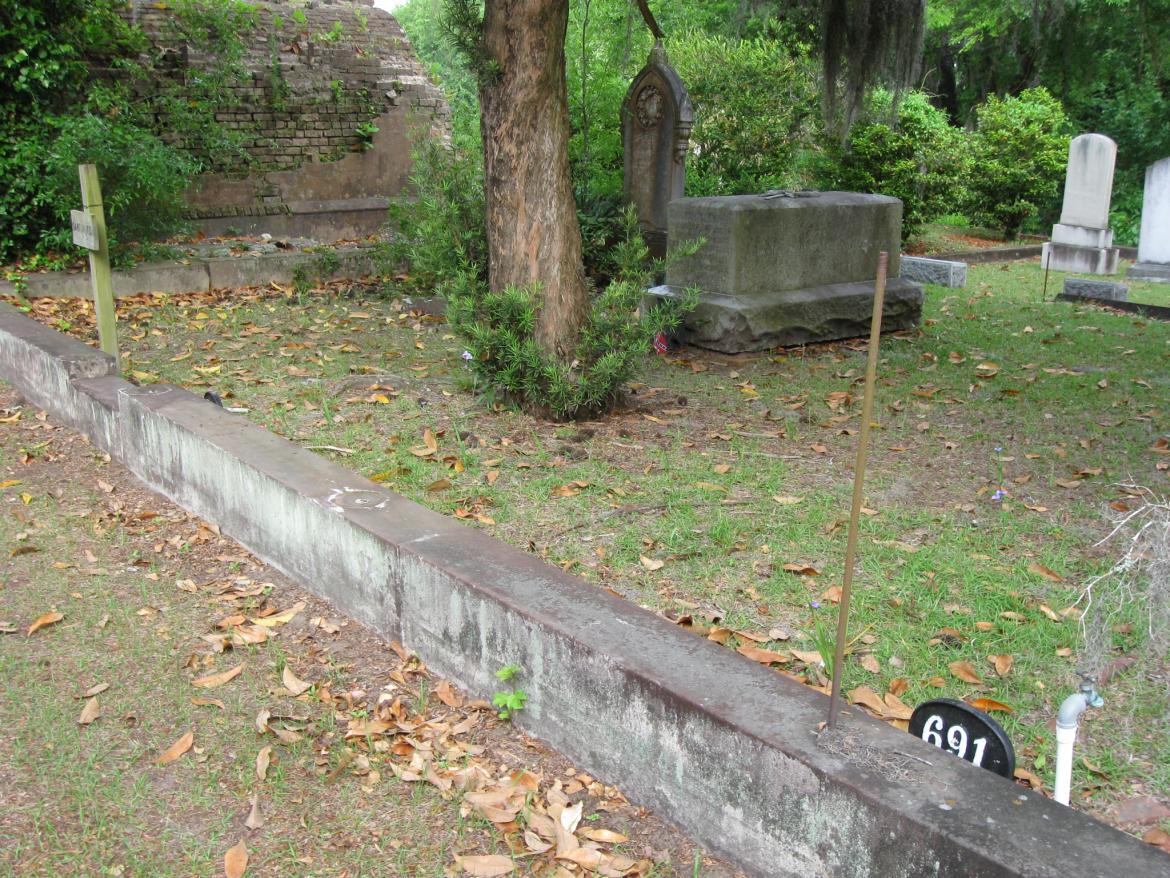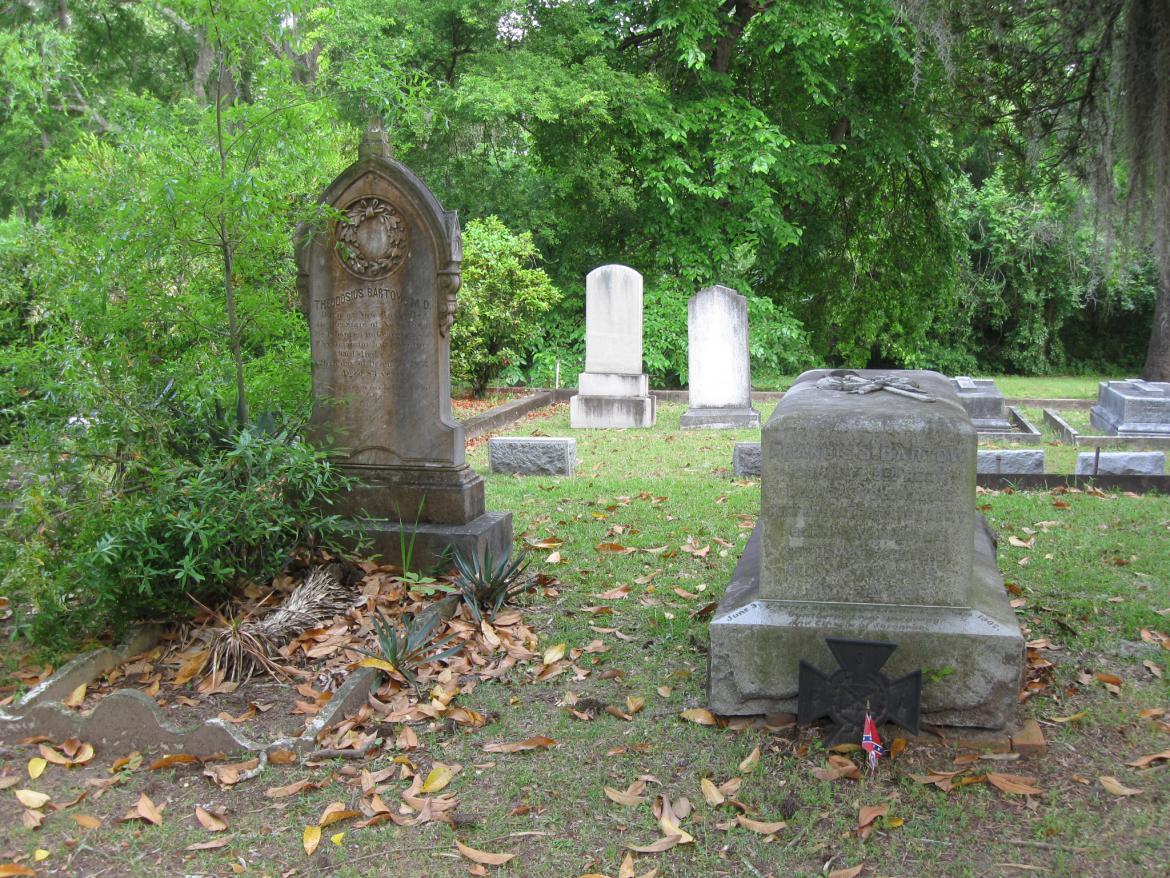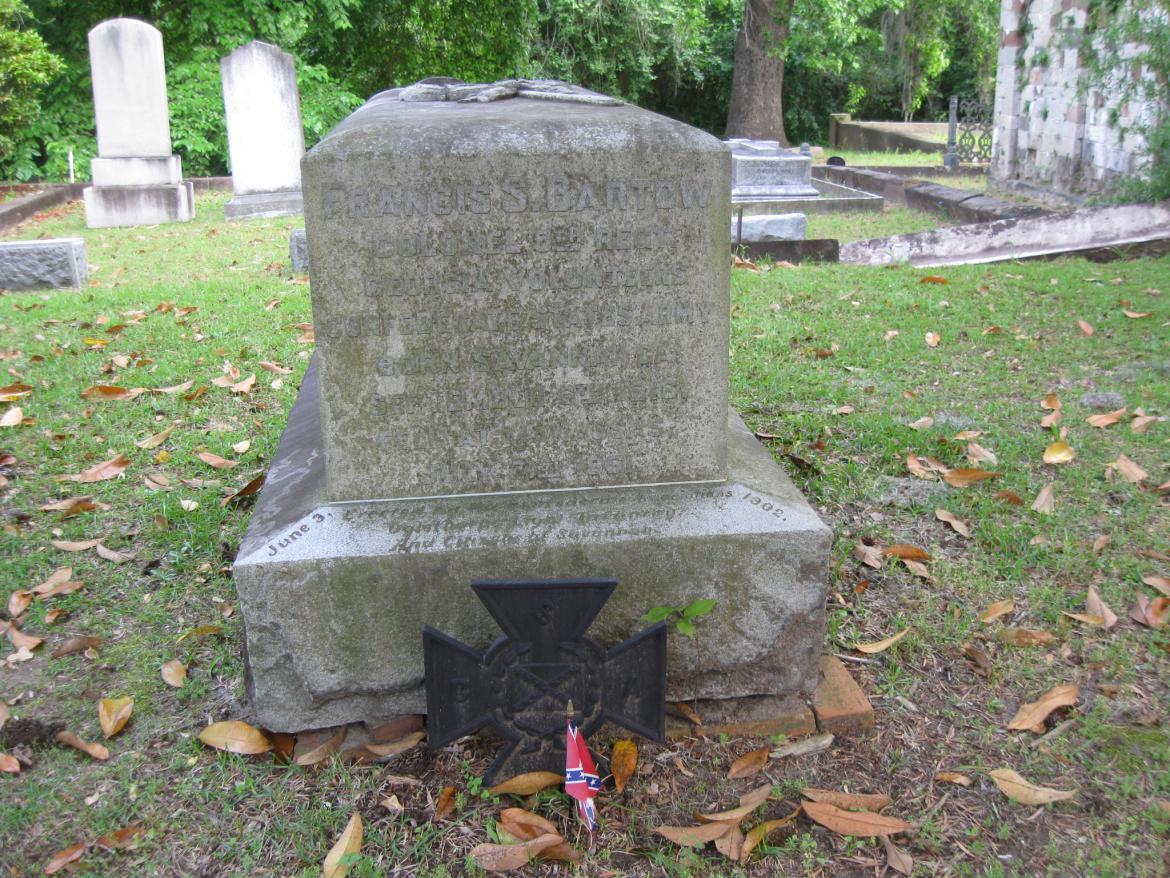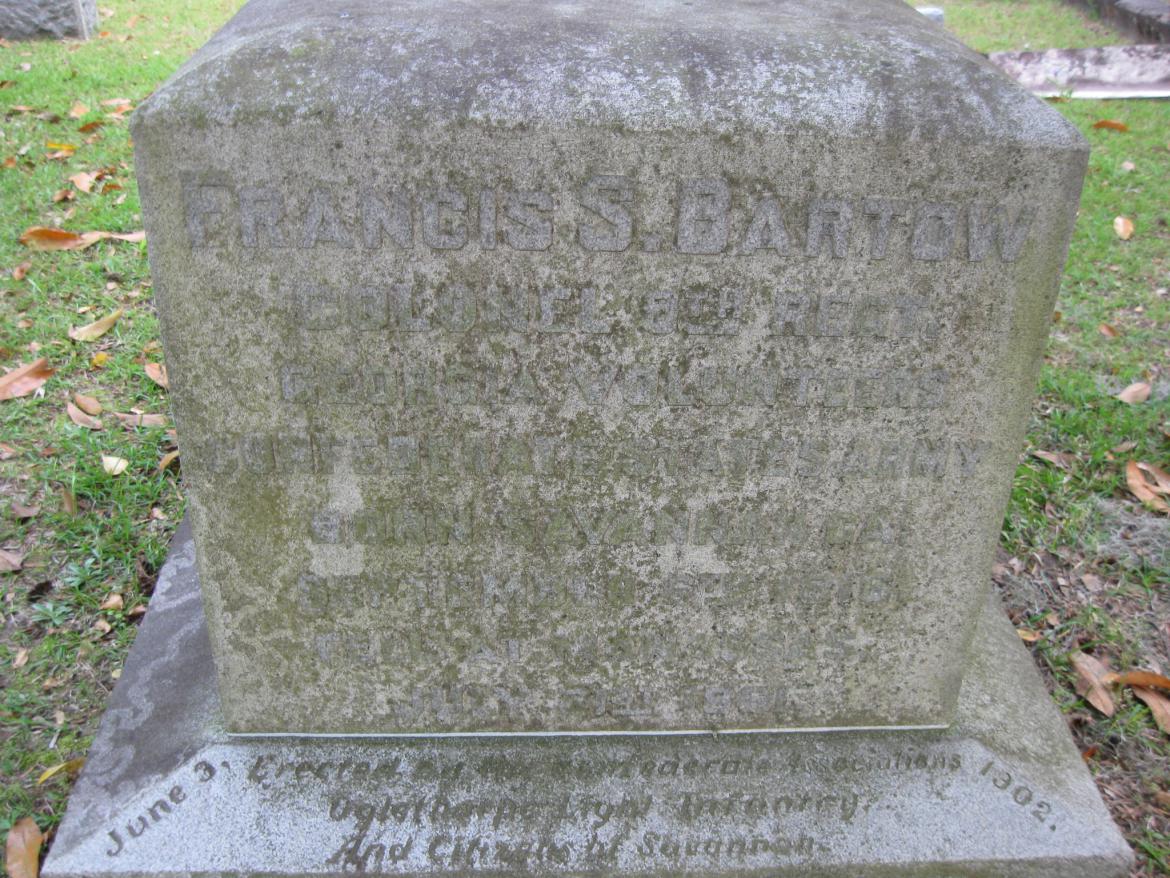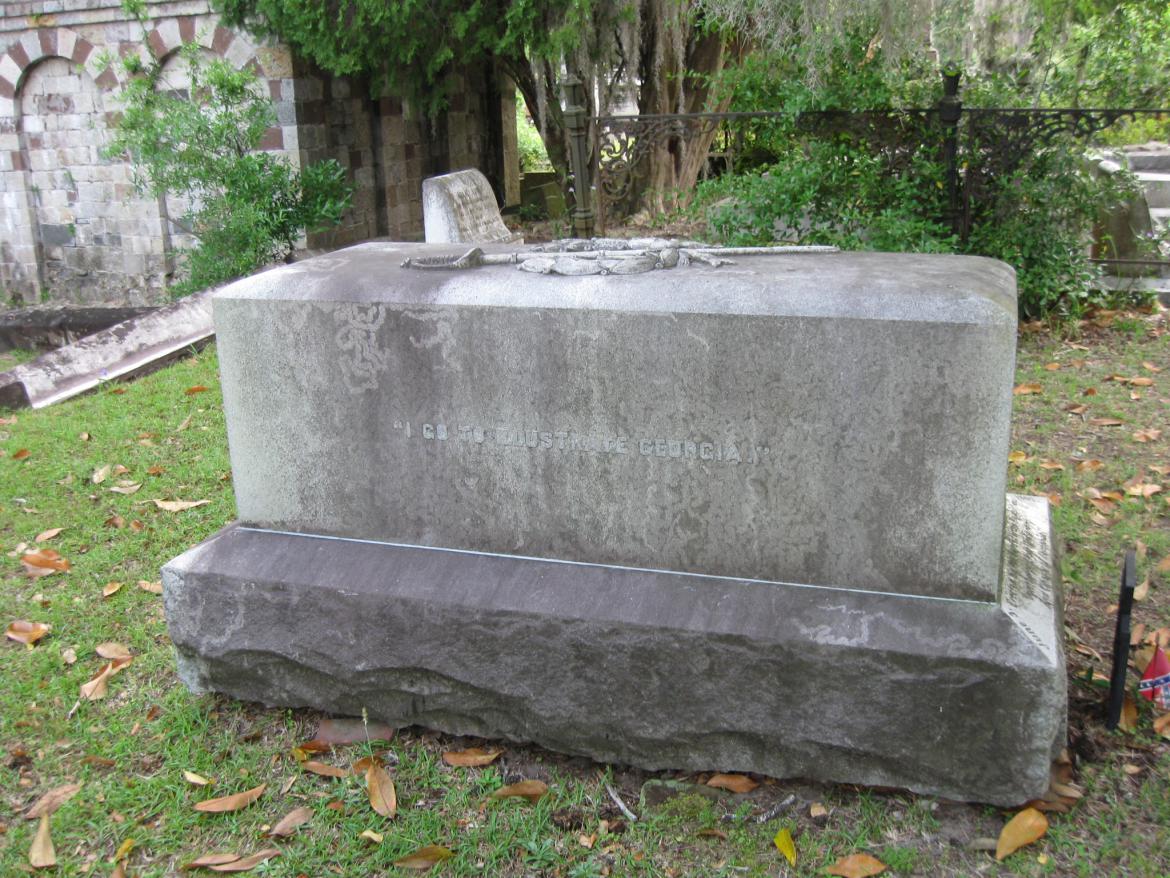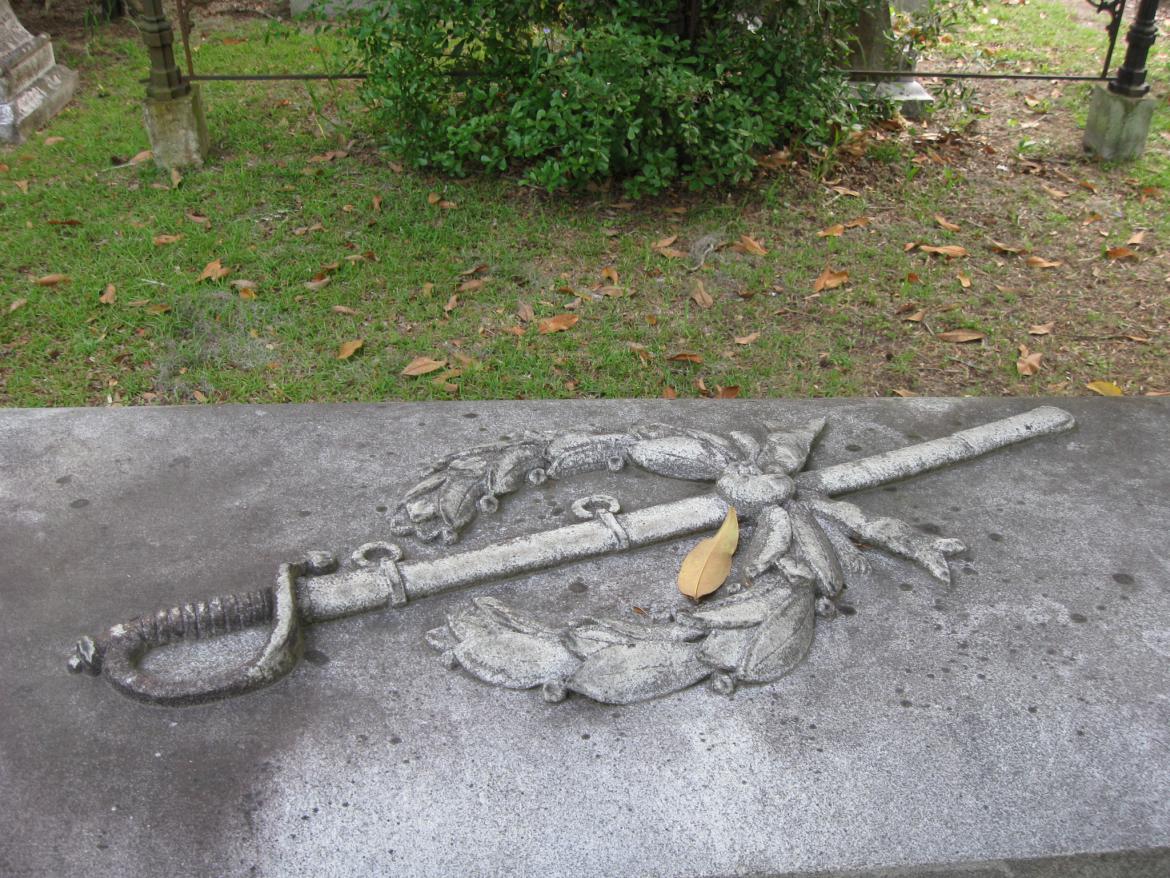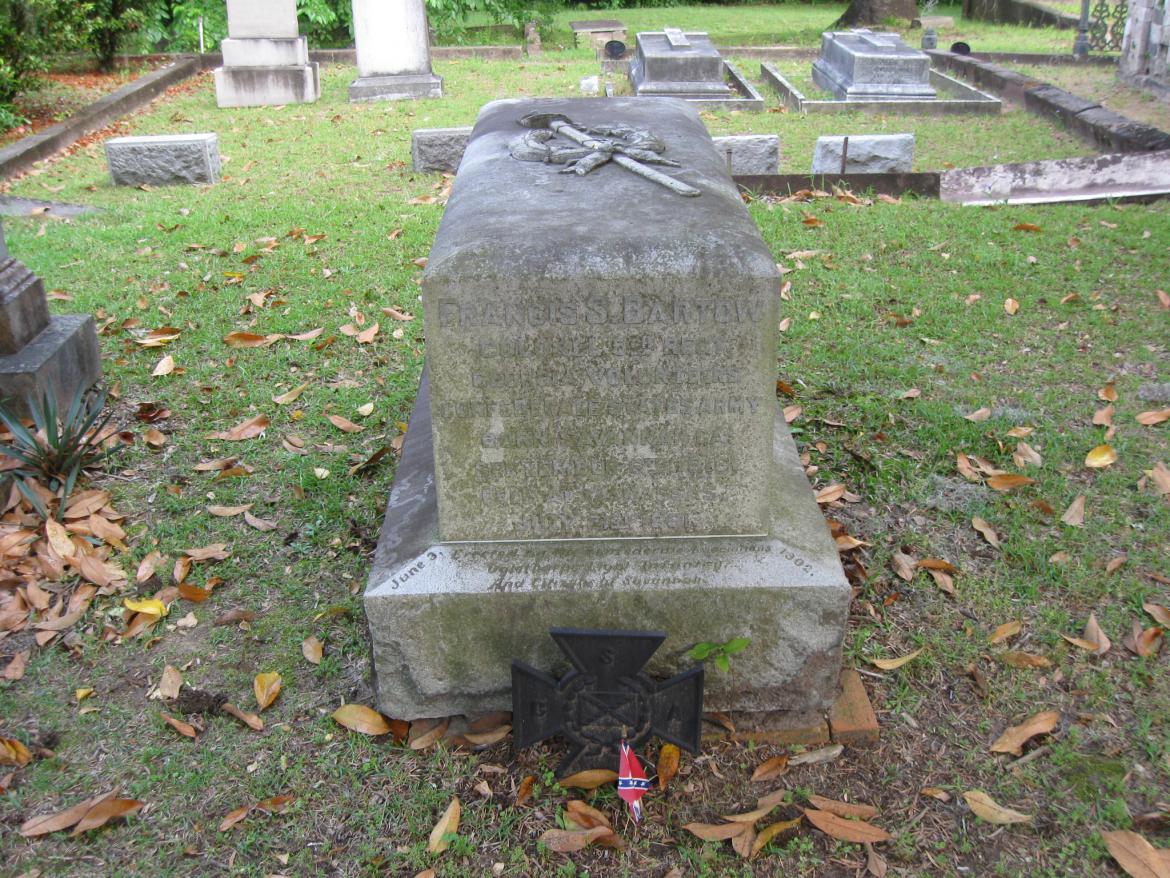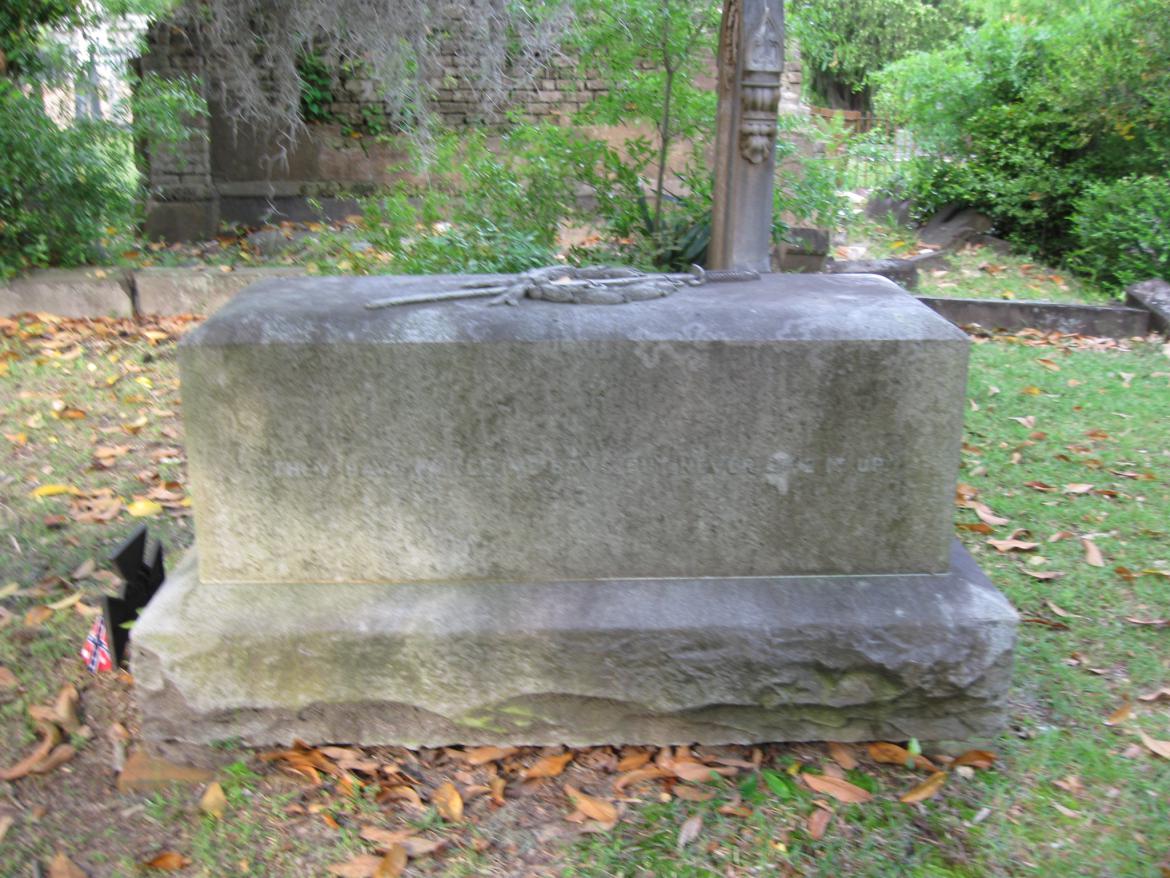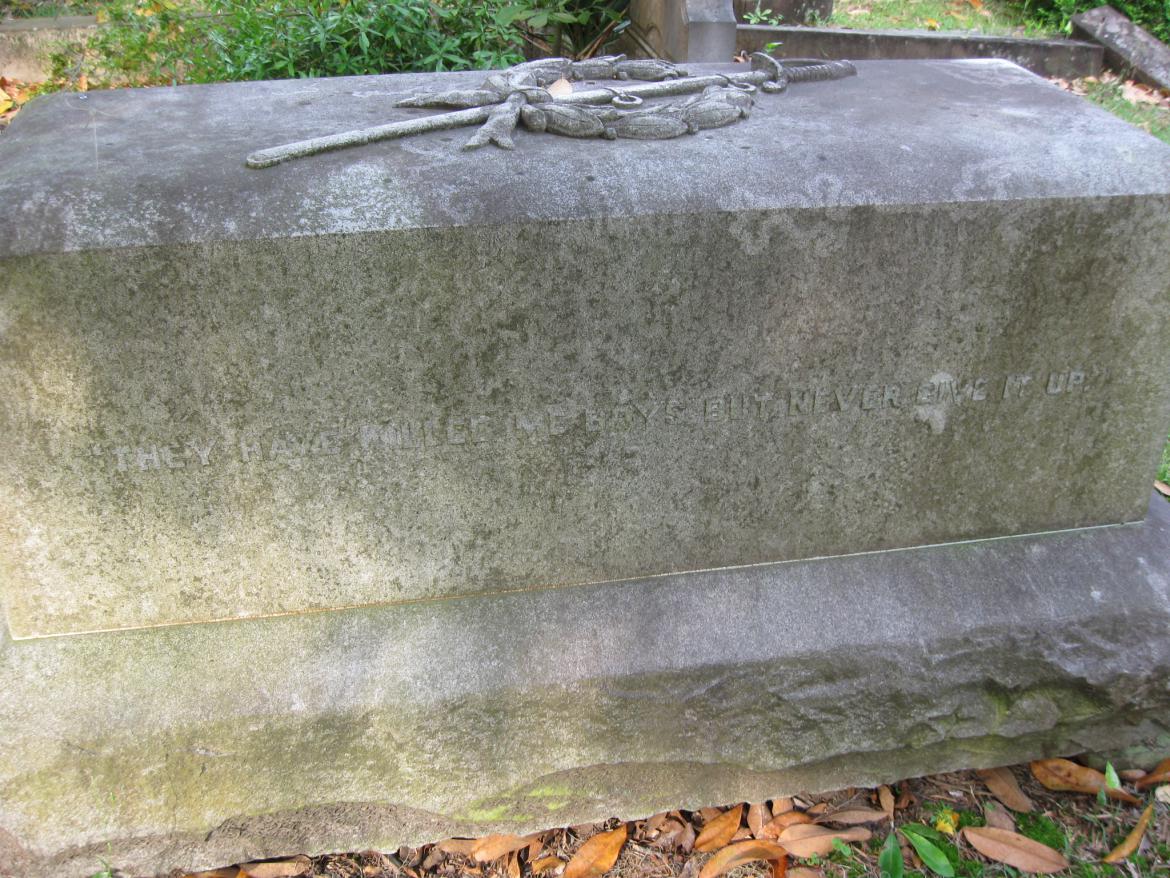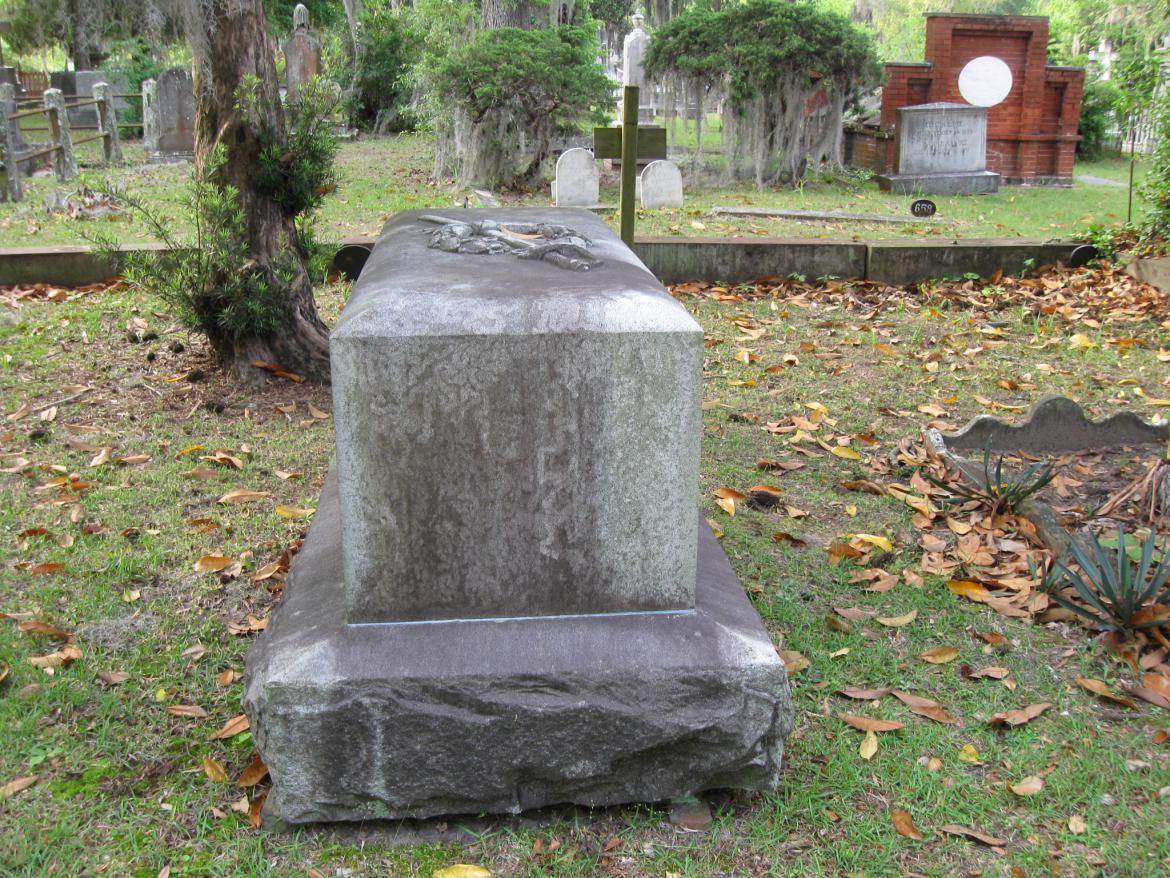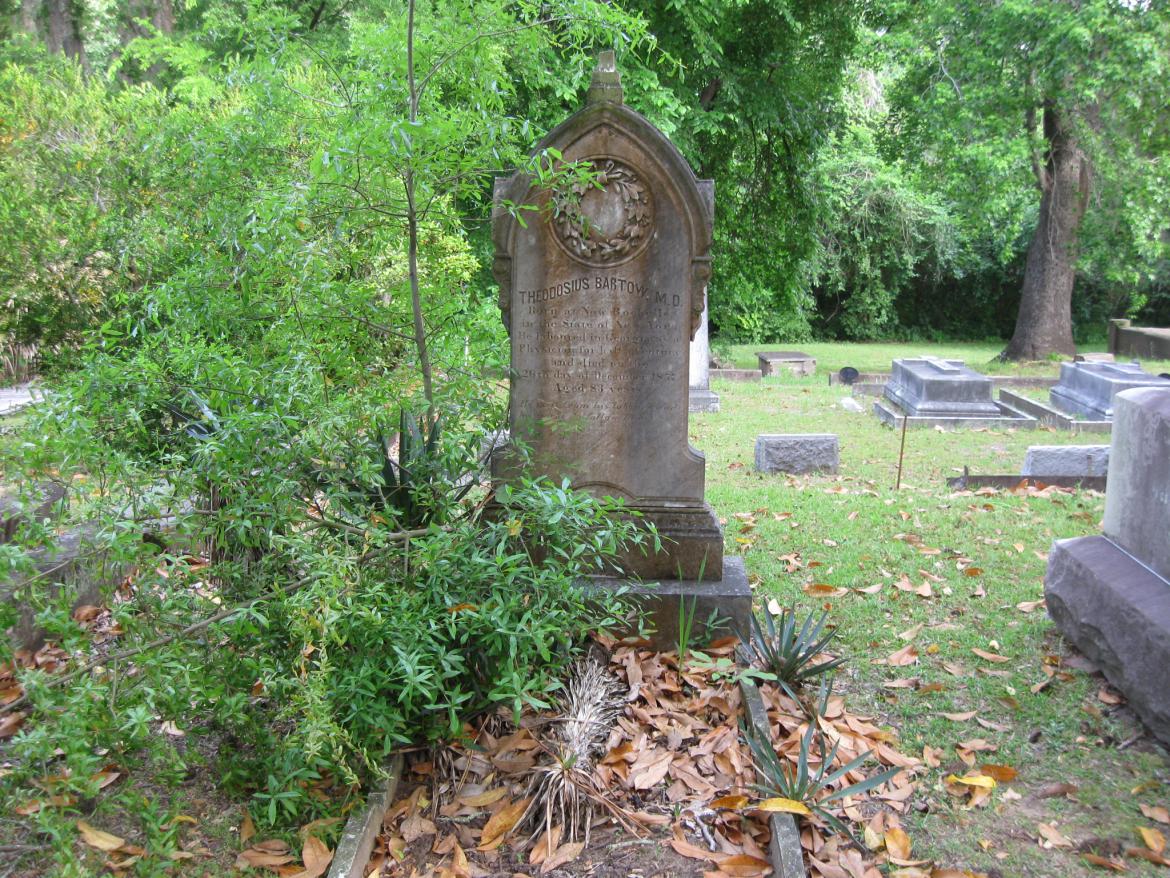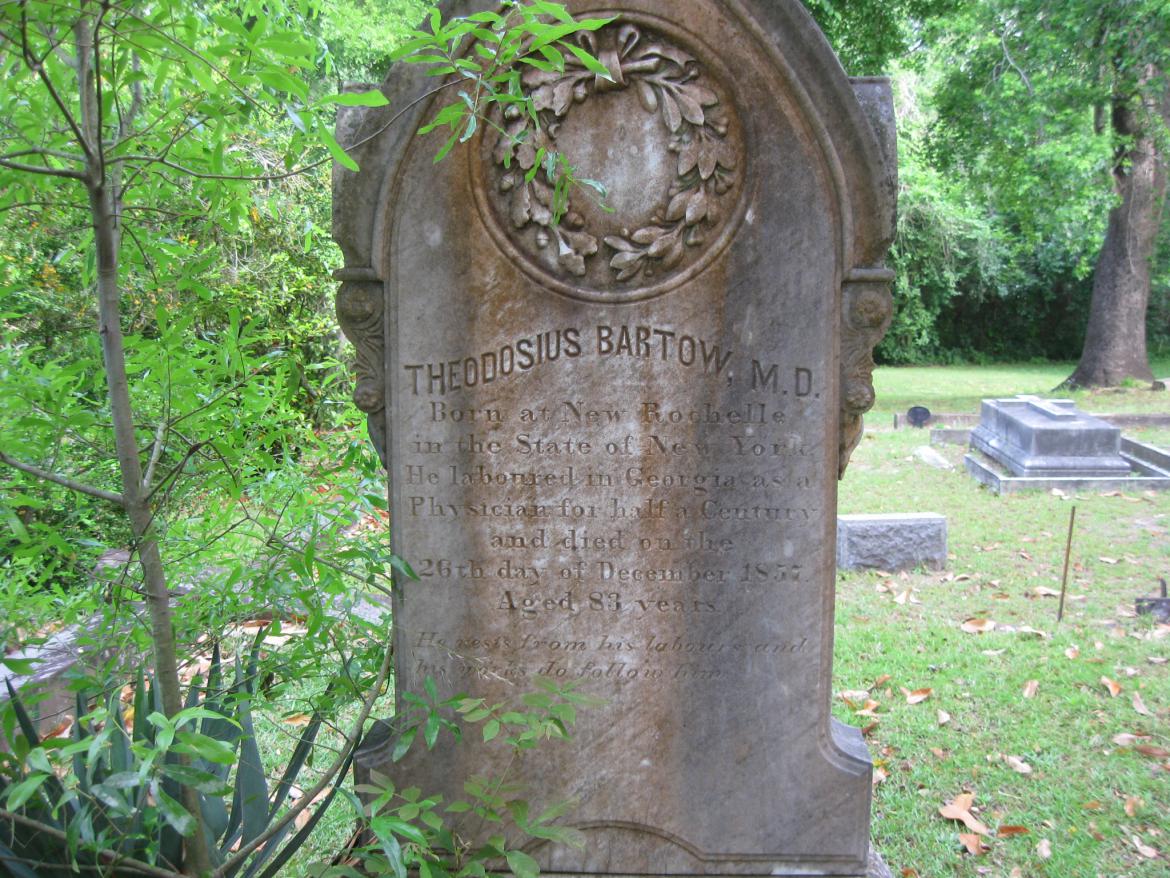In Savannah, Georgia’s Forsyth Park is a monument to Confederate Colonel Francis Stebbings Bartow (1816-1861). Bartow was the first colonel of the 8th Georgia Infantry Regiment, and the first commander of the brigade that would be George T. Anderson’s Brigade at Gettysburg. The 8th Georgia and Anderson’s Brigade (Hood’s Division, Longstreet’s Corps) fought in the area of the Wheatfield on July 2, 1863, and defended the south part of the battlefield against Farnsworth’s and Merritt’s cavalry brigades on July 3, 1863. This view was taken facing northeast at approximately 11:30 AM on Thursday, April 21, 2011.
The Gettysburg Daily took a journey to the Savannah, Georgia area this month. One of our purposes for the visit was to find Civil War events/personalities associated with Gettysburg.
In our first Savannah post we showed the monument and the grave of Confederate Major General Lafayette McLaws.
In today’s Savannah, Georgia post, we show the monument and the grave of Colonel Francis S. Bartow. They are very similar to the monument and grave of Lafayette McLaws.
This map shows the two areas in Savannah featured in this post. #1 is the area of the Confederate Monument in Forsyth Park. #2 is Laurel Grove Cemetery. This view was taken facing north at approximately 8:30 PM on Friday, April 29, 2011.
The Confederate Monument in Forsyth park is between the monuments to Lafayette McLaws (barely visible on the right) and Francis Bartow (not visible on the left) This view was taken facing northwest at approximately 11:30 AM on Thursday, April 21, 2011.
Francis Bartow was born in Savannah to a medical doctor, and studied law at Franklin College (now known as the Franklin College of Arts and Sciences at the University of Georgia). He graduated with high honors at the age of 19, and came back to Savannah to “read law.” He then went to Yale Law School in New Haven, Connecticut to take additional classes. This view was taken facing northwest at approximately 11:30 AM on Thursday, April 21, 2011.
In the 1840 presidential election, Bartow campaigned for the Whig candidate, William Henry Harrison. Bartow was elected to two terms in the Georgia House of Representatives and one term in the Georgia Senate. After he was defeated for an office in the United States Congress, he was elected as Captain to Savannah’s Oglethorpe Light Infantry, a militia unit that had been formed in 1856. It was not the oldest milita unit in the city, but was made up of the sons of prominent members of Savannah society. This view was taken facing southwest at approximately 11:30 AM on Thursday, April 21, 2011.
Bartow, the Oglethorpe Light Infantry, and two other Savannah militia units captured Fort Pulaski (on Cockspur Island, which controlled the entrance to the Savannah River) without opposition on January 6, 1861. Bartow served as a delegate to the Georgia Secession Convention and was very vocal in his desire to have George secede from the Union. Georgia seceded on January 19, 1861, and Bartow was elected to the Confederate Congress in Montgomery, Alabama. This view was taken facing northwest at approximately 11:30 AM on Thursday, April 21, 2011.
On the second day of the Confederate Congress, Bartow became chairman of the Military Committee. Approximately a month later he announced that he would take the Oglethorpe Light Infantry to Virginia, where the capital of the Confederacy was moving. This view was taken facing northwest at approximately 11:30 AM on Thursday, April 21, 2011.
The Bartow and McLaws busts, now located in Forsyth Park, were dedicated on June 3, 1902, the anniversary of the birth of Confederate General Jefferson Davis (which was a legal holiday in Georgia). However, the dedication ceremonies took place, here, in Chippewa Square, one of the many public parks in Savannah. The Bartow bust is located closest to the camera. The McLaws and Bartow monuments/busts were moved to Forsyth Park in 1910 because a large monument to Georgia founder James Oglethorpe was erected in Chippewa Square, where the fountain was located. This view was taken facing north circa the early 1900s.
When the busts were dedicated in Chippewa Square, there was an elaborate parade in which various Confederate Veterans organizations, the Sons of Confederate Veterans, civic groups, and Savannah’s military groups participated. The monument/bust to Bartow (closest to the camera) was unveiled by Francis Bartow Hight, a granddaughter of one of Frqncis Bartow’s sisters. This view was taken facing north on Monday, June 2, 1902.
This is the brochure given out to those who visit Laurel Grove Cemetery is which southwest of Savannah’s Historic District. It is a handy size and points out some of the important people buried in the cemetery. There is another map which we were given that lists each burial plot, but that was too big for our scanner. In our previous Savannah post we walked from the Circle surrounded by Cypress, Cedar, Willow and Elm Streets to the McLaws grave in the northeast quadrant, with the red star and the “M.” Today we will continue our walk to the grave of Francis Bartow, which is the red star with a “B.” This view was taken facing west at approximately 8:30 PM on Saturday, April 30, 2011.
We are back in Laurel Grove Cemetery. In our previous Savannah post we saw the grave of Lafayette McLaws which was located in aisle 18. We are moving farther to the west to aisle 21 to find the grave of Francis Bartow. This view was taken facing west at approximately 9:00 AM on Friday, April 22, 2011.
This is aisle 21. Francis Bartow had requested permission from Georgia’s Governor Joseph Brown to take the Oglethrorpe Light Infantry to Virginia. Brown refused because he thought it was more important to protect the coast of Georgia. Bartow decided to go anyway, and there would be a very public disagreement between the two men over Bartow’s duty and his taking equipment belonging to the State of Georgia (in Brown’s opinion) to Virginia. This view was taken facing north at approximately 9:00 AM on Friday, April 22, 2011.
You will notice that the Bartow monument looks like the McLaws monument. Except for the wording, they appear to us to be exactly the same. Also because the Bartow monument sits underneath trees, the “sap” from the trees falling on the monument makes it difficult to read. This view was taken facing northwest at approximately 9:00 AM on Friday, April 22, 2011.
Bartow went to Virginia, and became Colonel of the 8th Georgia Infantry regiment, consisting of other companies who had decided to go to Virginia under orders of Confederate Jefferson Davis, not Governor Brown. This view was taken facing northwest at approximately 9:00 AM on Friday, April 22, 2011.
The Bartow family lot marker, 690, is hidden behind the wall. This view was taken facing west at approximately 9:00 AM on Friday, April 22, 2011.
By the time of the Battle of First Manassas, on July 21, 1861, Bartow was commanding a brigade consisting of the following units: 7th, 8th, 9th, 11th Georgia Infantry Regiments, Duncan’s 1st Kentucky Infantry Battalion, Pope’s Kentucky Infantry Battalion, and the Wise (Virginia) Artillery. Only the 7th Georgia, the 8th Georgia, and Wise’s Artillery were present at the Battle of First Manassas. This view was taken facing southwest at approximately 9:00 AM on Friday, April 22, 2011.
During the Battle of First Manassas, Bartow and the 8th Georgia suffered heavy casualties after Bartow had led them into an exposed position. Bartow ordered his men to retreat, and then he rode to Confederate General Pierre G.T. Beauregard to ask for orders. Beauregard ordered him to “silence” a Union battery. This view was taken facing west at approximately 9:00 AM on Friday, April 22, 2011.
Bartow retrieved the 7th Georgia and attacked. In the area of Henry House Hill, his horse was shot from under him and he was “slightly” wounded by a bullet. He got on another horse and continued the attack. He yelled “Boys, follow me!” and waved his cap over his head. Another projectile hit his chest and lodged in his heart. His last words were “Boys, they have killed me, but never give up the field.” This view was taken facing west at approximately 9:00 AM on Friday, April 22, 2011.
Again, the words are difficult to read on the monument, but it was sponsored by the same groups that erected the monument over the grave to Lafayette McLaws. An exception is that members of the Oglethorpe Light Infantry also contributed to Barlow’s grave. Another item we noticed is that this monument was dedicated on June 2, 1902. If the McLaws and Barlow monuments in Laurel Grove were dedicated on this day, that means they were dedicated on the same day that their monuments/busts were unveiled in Chippewa Square. This view was taken facing west at approximately 9:00 AM on Friday, April 22, 2011.
The words on the south side of the monument are “I go to illustrate Georgia!” They were said at the Savannah railroad station when Barlow was preparing to depart for Virginia. It was a response to the criticism he was receiving from Governor Brown for leaving Georgia. This view was taken facing north at approximately 9:00 AM on Friday, April 22, 2011.
Bartow’s body arrived in Savannah the night of July 27, 1861. The public buildings were draped in mourning. They were escorted from the railroad depot by various military detachments to lie in state at Savannah’s City Exchange. The Exchange was the political, commerical, and social center for the City of Savannah. The various Savannah militia units had all occupied quarters in the Exchange prior to their own buildings being constructed. The Chatham Artillery fired a gun every minute as the escort moved from the depot to the Exchange. This view was taken facing north at approximately 9:00 AM on Friday, April 22, 2011.
The funeral took place on July 28, 1861 and “was the most solemn and imposing spectacle ever witnessed in Savannah.” At 3:00 PM, the miltary escort, consisting of all the city companies and detachments from the troops stationed in the Savannah area, escorted the remains from the Exchange to Christ Church. The funeral services were conducted by Right Reverend Stephen Elliott, the Episcopal Bishop of Georgia. After the services in Christ Church, the remains were carried to Laurel Grove, where they were placed here “with military honors.” “The universal expression of sadness was truly impressive, and proved how sincerely the entire community deplored the loss of one who was not less loved in life than honored in his glorious death.” This view was taken facing west at approximately 9:00 AM on Friday, April 22, 2011.
Sorry about the blurriness of the north side of the monument… This view was taken facing south at approximately 9:00 AM on Friday, April 22, 2011.
… but this closer, clearer view shows Bartow’s final words. This view was taken facing south at approximately 9:00 AM on Friday, April 22, 2011.
Besides any words on the back of the monument, something else is missing here, Bartow’s wife Louise Greene Berrien (1827-), whom he had married in 1844. She was the daughter of one of his mentors, Senator John Berrien. In 1865, Louise Green Berrien Bartow married Ephraim Mikell Seabrook of Edisto Island, South Carolina. Francis Bartow had signed the ordinance of secession for the State of Georgia. Seabrook had signed the ordinance of secession for the State of South Carolina. She was Seabrook’s third wife. This view was taken facing east at approximately 9:00 AM on Friday, April 22, 2011.
So Bartow is buried alongide his father… This view was taken facing west at approximately 9:00 AM on Friday, April 22, 2011.
Dr. Theodosius Bartow (1770-1857). This view was taken facing west at approximately 11:30 AM on Thursday, April 21, 2011.


